On October 8, 2016, as part of the Academy’s 2016 Induction weekend program, new Members were briefed on the Academy’s research projects and studies. The speakers, who play an active role in one or more Academy projects, highlighted the studies’ current activities and the many opportunities for new Members to participate. The presentations focused on Humanities and Education; Global Security and International Affairs; Science, Engineering, and Technology; American Institutions; and Exploratory Projects. What follows is an edited version of the speakers’ remarks.
Humanities & Education
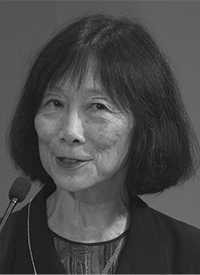
Pauline Yu
Pauline Yu is President of the American Council of Learned Societies. Elected a Fellow of the American Academy in 1998, she is a Member of the Academy’s Board of Directors. She also serves on the Advisory Group for the Lincoln Project: Excellence and Access in Public Higher Education and is a member of the Commission on the Humanities and Social Sciences.
At critical times over the past century, the Academy has assumed a leadership role in American higher education, particularly in support of the humanities. The Academy worked behind the scenes to develop new institutions, such as the National Humanities Center in North Carolina. In recent years, the Academy has taken a more public role, as the sponsor of the National Commission on the Humanities and Social Sciences, which released its influential report, The Heart of the Matter: The Humanities and Social Sciences for a Vibrant, Competitive, and Secure Nation, in 2013. The projects we will discuss today all follow in that tradition, as large groups of experts drawn from diverse fields come together to share their expertise and offer recommendations to support our nation’s educational institutions.
Before opening the discussion, I want to talk briefly about the Humanities Indicators project, so ably directed by the Academy’s Robert Townsend in our Washington, D.C., office. An ongoing Academy effort – launched in 2009 – this project represents a valuable resource for educators, policy-makers, journalists, and all those seeking data to assess the welfare of the humanities in the United States. Modeled on the Science and Engineering Indicators of the National Science Foundation, the Humanities Indicators make high-quality data available to anyone interested in the current state of the field, allowing them to study the context of present conditions, follow key trends, and predict emerging issues for the humanities disciplines. The Indicators are regularly updated at humanitiesindicators.org, providing an empirical basis for the ongoing national conversation on the state of the humanities. On this topic, I will just say that I’ll never forget the comment of Phyllis Franklin, who was the executive director of the Modern Language Association when this project was being discussed. When queried as to the necessity of a quantitative approach, she quipped, “If you can’t count, you don’t count.”
Commission on the Future of Undergraduate Education
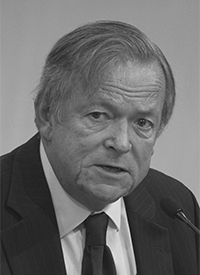
Michael S. McPherson
Michael S. McPherson is President of the Spencer Foundation. Prior to joining the Spencer Foundation, he served as President of Macalester College in St. Paul, Minnesota. He was elected a Fellow of the American Academy in 2014 and serves as Cochair of the Academy’s Commission on the Future of Undergraduate Education.
The diverse membership of the Commission on the Future of Undergraduate Education reflects the fact that undergraduate education has become an extremely broad category in the United States. We are taking on a range of institutions, focusing on the many opportunities that are available to people who have graduated from high school in the United States, from community colleges and for-profit institutions to the broad public universities and the great research universities.
The mission of the Commission is not a modest one. We’re influenced by the principle of making no small plans. We have undertaken a three-year project to examine the state of undergraduate education in America, and to provide ideas for how to ensure that individual Americans receive the education they need to thrive in the twenty-first century. We’re thinking about this challenge of the future from a generational perspective. At a time of great social demographic and technical change in education in the United States, we’re attempting to look ahead as far as twenty or twenty-five years. We are excited by the challenge, somewhat intimidated by the challenge, but determined to address this important topic in a very serious way.
There are seven main topic areas under discussion: framing the future of undergraduate education; inequality and inequity; costs and affordability; teaching and learning; the liberal arts and vocational education; the role of government regulation in an innovative age; and anticipating and responding to future trends. We are arriving at this work at a very challenging time for American society and the American economy, and with a strong belief that higher education has a critical role to play in the future of this society – not only as a successful, prosperous economy, but as a fair and progressive society with opportunities for all. At this time, more than 85 percent of all people who graduate from high school in the United States have some contact with a college or university – some experience of college enrollment – in the subsequent eight years. We’re coming very close to an idea of almost universal access for high school graduates. It’s not necessarily access on equal terms, but it is access. Success in college is a much more challenging proposition, and graduation rates fluctuate across different population groups tremendously. We know that even though higher education is important to most Americans – and that most Americans seek it – there is also increasing doubt about higher education, about the fairness of its provision, about the affordability of college and the burdens of loans, and even about the integrity of higher education, with some collegiate institutions being shut down by the federal government because they’re not being run in a responsible way. We want to tackle all of the practical projects and challenges that face higher education, but I want to emphasize that we will not limit ourselves to the narrow questions of paying for college and getting a job after college. Appropriately for this august institution, we intend to take on topics that address the values and the larger purposes of higher education. So you will see in our focus areas that we will have something to say about the liberal arts in relation to the occupational purposes of higher education. We will have something to say about what goes on inside colleges and universities; not simply what goes in and what comes out the other end, but the challenging process of studying, teaching, and learning. And perhaps most important of all, we will have something to say about the looming problems of educational opportunity in a time of growing material inequality in our society. We are at an early stage. We don’t yet have answers to any of these questions. We don’t have recommendations at this point. But those are some of the directions in which the commission is heading.
Debate about higher education is often based on rather elusive facts, and so we began early on to work with a data advisory group to make sure we have a good command of the best-available research and facts. The work of the data advisory group enabled us to produce our first publication, a fact-based, largely quantitative account of the current situation in undergraduate higher education in the United States, A Primer on the College Student Journey. It has, so far, been very well received. Aided by this data-rich foundation, we have also begun to undertake, and will continue to undertake, outreach efforts, congressional visits, meetings with students and faculty, and other forms of conversation around the country. We have so far had two meetings, and have another coming up next month. The final report will be published in the fall of 2017, something I keep reminding myself. And thereafter, we will go to great effort to communicate the conclusions and recommendations widely, and we are very interested in your perspectives on these issues. If you have questions, if you want to offer any input or thoughts, please let us know.
The Lincoln Project: Excellence and Access in Public Higher Education
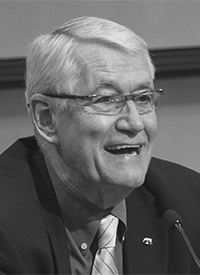
Robert J. Birgeneau
Robert J. Birgeneau is Chancellor Emeritus and the Arnold and Barbara Silverman Distinguished Professor of Physics, Materials Science and Engineering, and Public Policy at the University of California, Berkeley. He was elected a Fellow of the American Academy in 1987 and serves as Cochair of the Academy’s Lincoln Project.
We are at the exact opposite end of a project lifespan, so to speak, from the Commission on the Future of Undergraduate Education. Mary Sue Coleman – who was, when we began, president of the University of Michigan, and is now president of the Association of American Universities – and I are the cochairs of the Lincoln Project: Excellence and Access in Public Higher Education. The Lincoln Project has, in essence, looked at the specific challenges facing the approximately 145 public research universities across the United States. Our mission is to understand how we are going to maintain both the excellence and the accessibility of these institutions in the face of massive state disinvestments. How can we guarantee that these universities will continue to be public in character and serve the public in the way intended when President Lincoln established them through the Morrill Act more than 150 years ago?
The Lincoln Project advisory group consists primarily of members of the Academy and, by design, includes a broad cross section of disciplines and interests. This is because we believe that all sectors – the federal government, state governments, business, foundations, nonprofits, students and their families, and the universities themselves – all will have to contribute in order to guarantee the health of our great public research universities.
We have produced a series of five publications, each with a different focus: Why They Matter documents in detail the role of public research universities in our society. Changes in State Funding tells the rather desultory story of the massive disinvestment in higher education by state governments. Understanding the Financial Model explains the basic financial model that now obtains at most public research universities. We all suffer from the fact that no newspaper or major magazine seems to understand public university finances, and further, most university faculty do not seem to understand their own university’s financial model either.Serving the Public Good focuses on the many ways public research universities contribute to the educational, economic, and civic health of U.S. society, in addition to their major contributions in health care and quality of life. The final and longest publication, Recommitting to Lincoln’s Vision—An Educational Compact for the 21st Century, provides the project’s detailed recommendations for ensuring that public research universities can meet their core mission in the twenty-first century. I cannot do these publications justice in our short time today; accordingly, I encourage you to visit the Academy’s website to read these publications in full. I believe that overall these publications are very well done thanks to the terrific work by the Academy staff.
It is important to recognize first that there is at least one outstanding public research university in every single state in the union, and many of these states, like Michigan and Washington, have no elite private research university at all. Overall, public universities are overwhelmingly responsible for the collegiate education of this country: 88 percent of all students pursuing a B.A. attend a public university. This is in no way meant to denigrate the role that our outstanding private universities play, but relative to the postsecondary student population as a whole, their educational contributions are limited.
Given that public universities bear the responsibility for educating the great majority of college students, it is chilling to look at their budgets, as measured by expenditures per full-time equivalent student, compared with those of the corresponding privates. Specifically, private universities belonging to the Association of American Universities spend between three and four times more per student than do the publics. My colleague, Henry Brady, dean of the Goldman School of Public Policy at UC Berkeley, likes to say that this proves how efficient we are or, more colloquially, that we offer a Cadillac education at a Chevy price. Said less positively, this expenditure disparity demonstrates just how financially deficient we are.
We have seen an extraordinary state disinvestment in public higher education and a concomitant increase in tuition. These are in lockstep with each other: the progressive increases in tuition, which public universities have vigorously fought to keep as modest as possible, have been driven almost entirely by state disinvestment. So why has the state disinvested in public higher education? Elementary and secondary education costs, the states’ largest general fund expenditures, have steadily risen. Meanwhile, the cost of Medicaid, the second greatest state expenditure, has skyrocketed, eating away at public funds. Higher education is the third largest general fund expenditure, but is followed closely by corrections. Over the last thirty years, state investment in higher education has been static, while funding of corrections has gone up by 141 percent. In fact, twelve states, including California, spend more money putting people in prison and keeping them there than they spend providing Californians with a higher education. This is a national disgrace.
Of course this disinvestment directly affects tuition. Decreased state support is responsible for driving 80 percent of tuition increases at public research universities, while increased spending on instruction and spending on administration and support are responsible for only 9 and 6 percent, respectively. The data show that, on the whole, administrative bloat is a myth, and that administration costs have been kept under control at public universities across the country. There has been essentially no change in workforce composition at public research universities, except for, on average, a decrease in upper administration.
The Lincoln Project held regional meetings across the country, which produced some of our core conclusions. These include, first and foremost, that state disinvestment is a national phenomenon, and appears to be irreversible. Disinvestment has largely been compensated for by increases in tuition and greater reliance on out-of-state and international students, both of which do not appear to be sustainable. Further, commitment to access varies wildly between different states. Some states are deeply committed to addressing income inequality through higher education, while others, disturbingly, appear to have no interest in this core societal issue. One important conclusion of the regional meetings was the ubiquitous need to improve graduation rates. We also learned that while corporate America often provides support for contract-based applied research, the amount of support from American corporations for either core university operations or student financial aid is disappointingly small. We were gratified to find that, across the country, we have great public research university leadership. One of the primary responsibilities of this leadership is to ensure that universities continue to improve on their operational efficiency.
To conclude, I will briefly mention four of our specific recommendations: 1) institute a federal-state-private matching endowed chair program at public research universities in all fifty states; 2) repatriate offshore corporate funds, which now stand at more than $2.4 trillion, at a reduced tax rate and appropriate 1 percent of the gains for public higher education; 3) launch large-scale industry-sponsored undergraduate scholarships; and 4) increase financial aid for low-income students through private-donor, state, and university matching programs. We need both the federal government and major corporations to step up and begin to provide support for the operations of our public research universities, if these universities in turn are to continue to underpin the economic and civic health of the nation. Finally, this support must have access as an essential component.
Commission on Language Learning
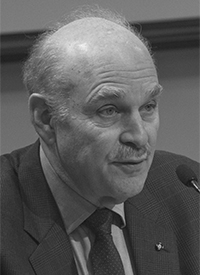
Rubén G. Rumbaut
Rubén G. Rumbaut is Distinguished Professor of Sociology at the University of California, Irvine. He was elected a Fellow of the American Academy in 2015 and is a member of the Academy’s Commission on Language Learning.
The United States has acquired a well-deserved but dubious reputation as a language graveyard. No other country in the world has received more multilingual peoples, and yet in no other country has a switch to monolingual English occurred as rapidly as it has in the United States. There are, today, some six thousand languages in the world, many of which are dying at a rapid pace. There are roughly two hundred nation-states; so there are many more languages in the world than there are states. The experience of bilingualism and multilingualism is normative in most countries around the world, but not in the United States. Still, as a result of an era of international migration to the United States over the last several decades, the percentage of people in the United States who speak English-only has declined from about 90 percent in 1970, the country’s linguistic nadir, to about 79 percent in the most recent American Community Survey (ACS) in 2015. In other words, 20 percent of the people of the United States now indicate that a language other than English is spoken in their home. But the ACS doesn’t ask how well they speak that other language, whether it be Chinese or Spanish or German or Tagalog. It turns out that only about half of that 20 percent speak a language other than English well.
Most people in the United States who speak a non-English language did not learn it in school. They are heritage learners. They’re immigrants or children of immigrants. The children of immigrants are losing that language, their home language, more rapidly than first generation immigrants – we can actually measure language death with survey methods. And so we have American-born residents failing to acquire second-language skills through school, and we have immigrants and children of immigrants who are not retaining and passing on their non-English language skills. The result is a self-inflicted national disadvantage in global business, in international diplomacy and security, in the exchange in research and ideas, and in our ability to communicate with our own neighbors.
In 2013, the American Academy’s Commission on the Humanities and Social Sciences released its report, The Heart of the Matter: The Humanities and Social Sciences for a Vibrant, Competitive, and Secure Nation. That report inspired a two-year campaign to support humanistic activity of all kinds, in partnership with universities, learned societies, academic associations, and humanities councils across the country. Among its recommendations, the committee declared, “We cannot ensure that people will be empathetic, but we can ensure that they have the knowledge and experience they need to be able to see the world as others see it.” The Heart of the Matter made a very strong case for the importance of the humanities in international and multicultural contexts, and it made a strong case in particular for language acquisition. Based on the strength of that Commission’s efforts, the American Academy received two letters in November 2014 expressing a bipartisan request – from eight members of Congress, four each from the Senate and the House of Representatives – to undertake a new study of the nation’s language education needs. The letters noted, “The ability to communicate in languages other than English has never been more important, given that American jobs and exports are more dependent than ever on foreign markets. The American population is increasingly multilingual, Americans are more engaged, diplomatically and militarily, around the globe than ever before, and challenges like poverty and disease, and opportunities in scientific research and technological innovation, all require international understanding and cooperation.” They concluded by asking the Academy to provide answers to the following two broad questions. First, how does language learning influence economic growth, cultural diplomacy, the productivity of future generations, and the fulfillment of all Americans? And second, what actions should the nation take to ensure excellence in all languages, as well as international education and research, including how we may more effectively use current resources to advance language attainment?
In response to this request, the Academy created the Commission on Language Learning, of which I am a part, currently funded by the Andrew W. Mellon Foundation, the Henry Luce Foundation, and the Academy’s own New Initiatives Fund. It was clear from the beginning that this Commission would capture some public excitement. The initial press release received more Web hits and views than any other announcement of an Academy project. The Academy’s excellent staff, some of whom are here today, continue to receive calls from philanthropic, news, and professional organizations, asking for details about publication dates. This public interest reflects both the importance of the subject matter and the timeliness of the forthcoming report.
The Academy began to organize the Commission in 2015, first by soliciting a series of white papers, four of which have been published on the Commission’s website. The full Commission has now met three times, in December 2015, February 2016, and last June, and we will meet once more, in November. In addition to full committee meetings, four subcommittees have met throughout the year. The research and data subcommittee, on which I serve, has developed a short publication that provides a statistical overview of the United States’ current language capabilities. You can expect to receive our published report in a few weeks. The technology subcommittee is looking for innovative ways to address outdated classroom resources and the diminishing supply of language teachers. Third, a subcommittee called “America in the World” is considering how the development of more robust language capabilities will make the United States more effective, politically and economically, in an international context. And finally, the fourth subcommittee has been charged with evaluating how enhanced language capacity contributes to a more welcoming, productive, and peaceful society. The Commission is now writing its final report, which is scheduled for release in early 2017. Like the statistical portrait, it will be published in both hard copy and electronic form, and will be distributed nationally. It will also be supported by a busy schedule of events across the country over a six-month period. We are also, naturally, considering the translation of the executive summary into languages other than English.
Throughout this process, the Commission has been in contact with organizations and congressional offices both for advice and to ensure that the Commission’s initiatives align with those of possible partners, including the National Foreign Language Center, the National Endowment for the Humanities, the Department of Education, the National Humanities Alliance, Gallaudet University, the British Academy, and the Yale Center for Language Study. At its most recent meeting, the Commission chose to highlight eighteen different recommendations in the final report, drawn from a list of more than sixty ideas discussed over the past year and a half. They fall into five broad categories: recommendations for increasing the teaching workforce; for streamlining teaching and assessment across cities and states; for encouraging heritage speakers to flourish both in their heritage languages and in English; for enhancing dual language learning opportunities for students who come from homes in which English is the dominant language and for students who come from multilingual families; and for the effective deployment of technology and digital resources in language learning. Not all eighteen ideas will be given equal weight in the final report. Some are merely illustrative of broader themes, or are parts of a menu of possible responses to particular challenges.
I’ll briefly mention one recommendation. As the report will make clear, monolingualism is a curable disease. But we cannot wait until middle school or high school to attack it. It is critical to start early; by age two or three, the brain is generating trillions of new synapses, and language is acquired most easily during the first ten years of life. So one specific recommendation is to begin language learning as early as possible, not to wait until it’s needlessly late, starting at a deficit.
The final report’s overarching argument is clear: language learning is a vital part of the American educational enterprise and is critical to the nation’s prosperity and security, as well as to the success of communities and the fulfillment of individuals in the United States. Our challenge has been to make the recommendations as strong as possible, not only to outline a strategy to improve language education in the United States, but to meet the urgent needs of our current moment in history.
Global Security & International Affairs
Committee on International Security Studies & The Global Nuclear Future
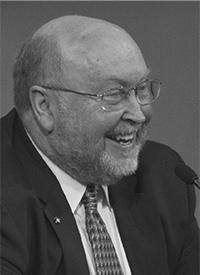
Steven E. Miller
Steven E. Miller is Director of the International Security Program at the Belfer Center for Science and International Affairs at the Harvard Kennedy School. He was elected a Fellow of the American Academy in 2006 and serves as Cochair of the Academy’s Committee on International Security Studies and Codirector of the Academy’s Global Nuclear Future Initiative. He is a Member of the Academy’s Council.
Let me add my voice to those congratulating you. I would add that, if I extrapolate from my own personal experience, what you have in front of you is not only an honor, but a wonderful opportunity. Over the last twenty years, a large portion of my own personal research agenda has been undertaken through and under the auspices of the American Academy. It provides tremendous support. It creates openings for both work and impact that wouldn’t otherwise exist. I would very strongly encourage you to get involved in the Academy’s projects and works and take advantage of the support provided by its members, its governing bodies, and its staff.
I have two responsibilities here. First I will briefly describe the history of the Committee on International Security Studies (CISS) and then I will give a quick overview of one of our current projects, the Global Nuclear Future. For some six decades, the Academy, through CISS, has played a prominent role in the international security debates in this country. In the late 1950s, under Academy auspices, CISS generated the original work that was absolutely formative in establishing the notion of arms control as a useful instrument of national policy. What started out in 1958 or 1959 as an interesting academic, experimental project would, fifteen years later, give rise to the first strategic arms control agreements between the Soviet Union and the United States. And over a four-decade period, we were able to put into place a set of negotiated structures that governed and constrained the dangers of the nuclear arms race between the Soviet Union and the United States. You can trace the intellectual origins of that whole exercise right back to the American Academy. During the 1980s, the Academy was a key player in the debate over ballistic missile defenses and the reaction to President Reagan’s so-called star wars program. In the 1990s, prompted by the protracted crisis in the Balkans, the Academy did some very thoughtful and influential work on issues of sovereignty and intervention: under what circumstances and what cases are international actors entitled to intervene militarily in the affairs of individual states, in violation of the deeply embedded norm of sovereignty.
Another recent CISS project undertaken under Robert Legvold’s leadership was the study of the security organization of what we call the post-Soviet space: the fifteen independent states established in Eurasia following the Soviet Union’s disintegration. How would that space be structured and organized in a way that could produce stability and security? The provisional answer today is that the international community has failed in that particular exercise. Our late colleague, John Steinbruner, with whom I had the privilege of being cochair of this committee, was a pioneer in championing and exploring what you might call the governance and constraint of unregulated, dangerous technologies. He did work on bio warfare. He did work on the military uses of space. In the last phase of his life, just before he fell so ill, we began to creep into the area of cyber warfare. How do you think about creating a governance mechanism that enables us to exploit the benefits of these technologies while avoiding or minimizing the adverse security consequences that might flow from them? Earlier this year, the Academy published a volume, edited by Elisa Harris, on this subject, Governance of Dual-Use Technologies: Theory and Practice.
Turning from the past to the present, we now have four projects underway: Understanding the New Nuclear Age; New Dilemmas in Ethics, Technology, and War; Civil Wars, Violence, and International Response; and the Global Nuclear Future, which is our longest-standing active project and which I will briefly introduce.
The Global Nuclear Future Initiative is looking at the global appetite for nuclear power and trying to assess and help constrain the potential nuclear proliferation implications of the spread of nuclear power. In the last decade, we have seen a tremendous upsurge in the interest and the pursuit of nuclear power. Some of this had to do with triple-digit per-barrel fossil fuel prices, which no longer exist. Some of it has to do with climate change. Some of it has to do with energy security and diversification of energy portfolios. But in places as far flung as Vietnam, Indonesia, Malaysia, Turkey, Abu Dhabi, and Iran, we see decisions already being taken and substantial investments being made in the pursuit of nuclear power, for the generation of nuclear electricity. But many of the technologies associated with nuclear power are dual-use, meaning that they have direct weapons applications or implications. The spread of these technologies to new states can increase the risk that nuclear weapons will spread to new actors. That’s generally regarded as undesirable. Certainly from the point of view of American security, that is undesirable. So how do we think about addressing this problem?
We have focused this project on what we call the nuclear newcomers, asking the question: if these states are going to have nuclear power, whether we like it or not, how can we maximize the likelihood that they do so in a safe, secure, and proliferation-resistant way? Part of the answer is by engaging with the scientific and political communities in these countries, trying to build networks and share best practices with them. We’ve had meetings around the world. We’ve produced a number of publications on topics from insider threats and nuclear disarmament to used-fuel storage and nuclear liability. We’ve done extensive work in places like Turkey, Abu Dhabi, and, to a lesser extent, Vietnam.
For several decades, we had a very stable global nuclear order, consisting of thirty nuclear power states and roughly 440 installed reactors around the world. But in recent years, more than sixty additional states have approached the International Atomic Energy Agency and expressed a serious interest in pursuing nuclear power. Many of those countries will never get very far down the road toward nuclear power, but the so-called spearhead states are moving ahead. Iran, for example, already has an operational reactor connected to the electricity grid and generating electricity. There are well-known worries about Iran’s possible interest in nuclear weapons, but whatever else Iran is doing, it is pursuing nuclear electricity. It is the first new nuclear power state in the world in a quarter of a century. Similarly, Abu Dhabi has four reactors under construction. The first reactor will be connected to the grid next year. Turkey has two large contracts, each for four reactors, which may go into operation in the span of ten or twelve years. Saudi Arabia has a very ambitious medium-term program to build a dozen or more nuclear power reactors, plus a declaratory policy of having all of rival Iran’s technology portfolio, meaning they claim to be pursuing exactly the worrisome dual-use technologies that made the Iran crisis so troublesome over the last dozen years. You can do a similar kind of exegesis of the situation in Southeast Asia, a region where there has been no nuclear power in the past but where there is widespread interest in nuclear power today. So the future is not going to be like the past. The world is changing, and we’re trying to do something about it.
Understanding the New Nuclear Age
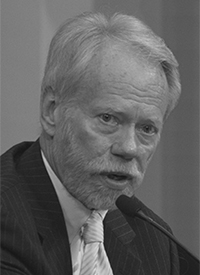
Robert Legvold
Robert Legvold is Marshall D. Shulman Professor Emeritus in the Department of Political Science at Columbia University. He was elected a Fellow of the American Academy in 2005 and serves as Chair of the Academy’s project on Understanding the New Nuclear Age.
At the end of the Cold War, attention shifted from the threat of nuclear armageddon resulting from the aggression of two nuclear superpowers to the proliferation of weapons of mass destruction, including nuclear weapons. In the process, we stopped thinking about the complex dynamic that was emerging among the nine nuclear powers – that is, what is today a multipolar nuclear world as opposed to essentially a bipolar nuclear world in the Cold War – and the challenges and the dangers that this new, multipolar world raises.
In this rapidly evolving new nuclear order, bilateral nuclear relationships, like that between Russia and the United States or India and Pakistan, are rapidly evolving into trilateral, or triangular, nuclear relationships. Here, the nuclear advances of China have become an increasingly important complicating factor. Further, the determination of China, India, and Pakistan to create strategic nuclear triads – that is, nuclear weapons on land, at sea, and in the air – combined with commitments by Russia and the United States to modernize their existing triads, is transforming the overall nuclear landscape in substantial ways. The return to a competition between offense and defense – missile defense and the missiles to overwhelm it – are adding to the upset, and this time in multiple forms, because India, China, and Pakistan are headed down the same route, with the United States and Russia in the lead.
Another dimension of significant change in the new nuclear order is the advance of nonnuclear weapons capable of attacking nuclear facilities, nuclear defenses, and their auxiliary components, thereby threatening the firebreak between conventional and nuclear war. Growing cyber capabilities, when incorporated into nuclear war-fighting, are also a fundamental threat to the premises that underlie the notion of strategic stability, the concept that emerged from the Academy’s arms control work in the 1950s. Finally, thinking about nuclear weapons and their reasons for being has taken on an ominous quality, in all quarters: more countries are assigning these weapons deterrence functions that go far beyond simple deterrence of a nuclear attack against them, while at the same time devising strategies for the use of these weapons in war.
The purpose of the Understanding the New Nuclear Age project is to bring all of these parts and the many increasingly complex dimensions together to develop a way of thinking about the whole – and to prod government and the broader expert community to begin doing the same. Then, ultimately, we will explore what can and should be done to deal with the overarching challenge, not merely the pieces of it, however important they are and however much expertise and experience we already have in addressing them. To proceed, we’ve assembled a working group of some of the country’s most seasoned specialists, who focus on different parts of the problem, and we’ve added to it a cohort of the brightest young members of the successor generation. We have commissioned a number of papers to stimulate the group’s thinking, which will eventually be published as either a monograph series or as a book intended to serve as a first cut on the subject. That is, the first effort to think about the new age in its complexity and whole, rather than just the composite parts. From there we’ll push the analysis deeper, pursuing collaborations, both here and abroad, that will allow some of these ideas to begin gaining traction and, one hopes, to shake audiences, beginning with policy-makers, from their current complacency.
In all of this we’re mindful that the fading fortunes of arms control, the worsening tensions between the United States and Russia, and the risk that the U.S.-China relationship could veer toward a genuine strategic rivalry, represents an inauspicious context for this work. But at the same time, never could it be more important. Thank you.
New Dilemmas in Ethics, Technology & War
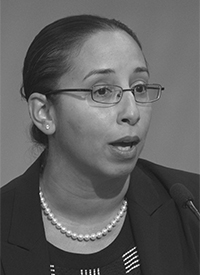
Tanisha Fazal
Tanisha Fazal is Associate Professor of Political Science and Peace Studies at the University of Notre Dame. She is a Member of the Steering Committee of the Academy’s New Dilemmas in Ethics, Technology, and War project.
I want to add my congratulations to this year’s new inductees to the Academy, on behalf of those of us who would one day like to be on that side of the table. I’m delighted to be here today to talk to you about this project on New Dilemmas in Ethics, Technology, and War. At the heart of this project is the ongoing adaptation of what is called “just war theory” to a new and changing international landscape, driven in part by new weapon systems and technologies. Just war theory is not just about war, but is about a set of ethical questions around the commencement, conduct, and conclusion of war, including the peace (or not) that follows. Are there conditions under which it is morally defensible to actually engage in war? What are the moral obligations of powers that take prisoners of war? There’s a relatively new segment of just war theory that is talking about the ethics of war termination, and here there are some very serious questions about the trade-off between justice, especially for the victims of war, and peace. We saw this in action earlier this week, with the failed referendum on the Colombian peace agreement.
The project exemplifies the ways in which the Academy can bring together high-quality scholarship and high-level policy outreach. One example is the Fall 2016 and Winter 2017 double issue of Dædalus produced by this project. Following the publication of the first volume earlier this fall, Scott Sagan, the project chair, and Jeffrey Lewis condensed their essay into an op-ed for The Washington Post, in which they call for a revision of U.S. nuclear targeting policy to conform to the laws of war, including a commitment not to use nuclear weapons against any target that could be reliably destroyed by conventional weapons.
Another example of our project’s marriage of high-quality scholarship and policy outreach is the set of briefings that several of us, including myself, presented this past May in Geneva. We were principally talking to the United Nations High Commission on Refugees (UNHCR), and I have to say this was a really exciting opportunity, but was also very challenging, because none of us in our contributions, or really in our own research, were directly addressing questions concerning refugees. And so we were forced to think about how new technologies of war, like drones and autonomous weapon systems, might be applied to a humanitarian context. In what ways could they be used to aid humanitarians in their work? We also discussed ethical issues concerning taking testimony from refugees that might, later on, be used to prosecute war criminals.
Another strength of this project has been that it has pushed just war theory forward by spotlighting the most common form of war today, civil wars. Both modern just war theory and also the modern body of multilateral treaties that make up the laws of war, like the Geneva Conventions, were created in an era when wars between states – interstate war – was the most common form of armed conflict. But that’s no longer the case. Today we’re much more likely to see wars within states. One of the essays to be published in the second Dædalus volume this January is Allen Weiner’s legal analysis arguing that there are certain conditions under which soldiers from rebel groups ought to be accorded the rights and privileges of lawful combatants, including prisoner-of-war status. My own contribution, also out in January, reverses the lens and looks at the laws of war from the perspective of rebel groups. My basic argument is that the political aims of different rebel groups condition how they fight and their relationship with the laws of war. In particular, I look at secessionist rebel groups – groups that want their own independent, internationally recognized state – and argue that, because they seek membership to the club of states, they want to send signals of being good and capable members of the international community, including by being better abiders of the laws of war than rebel groups with other types of political aims, such as overthrowing the central government. My research shows that secessionists, for example, are significantly less likely to target civilians than other types of rebel groups. And not only are they better behaved than other types of rebel groups, but they also tend to publicize this behavior, oftentimes contrasting it with the behavior of the governments against which they’re fighting, who are, very frequently, very badly behaved.
Finally, let me mention that these Dædalus issues bring in new perspectives on just war theory from not just political scientists and moral philosophers, but from other disciplines. There’s a terrific essay by Paul Wise, a pediatrician, who argues that we have to consider the long-term health impact of war in order to be able to evaluate the conditions under which it is or can ever be just. And with that mention of Paul Wise’s essay, I’m going to turn the baton over to Karl Eikenberry, who leads a project that both Paul Wise and I are also a part of.
Civil Wars, Violence, and International Responses
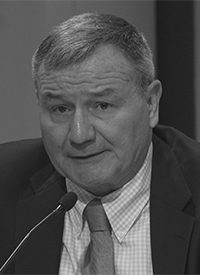
Karl W. Eikenberry
Karl W. Eikenberry is the Oksenberg-Rohlen Fellow and Director of the U.S.-Asia Security Initiative at the Shorenstein Asia-Pacific Research Center at Stanford University. He is the former United States Ambassador to Afghanistan and a retired U.S. Army Lieutenant General. He was elected a Fellow of the American Academy in 2012 and serves as Cochair of the Academy’s project on Civil Wars, Violence, and International Responses.
I’m pleased to introduce a new Academy project that I lead with Stanford University professor and American Academy Fellow Stephen Krasner: Civil Wars, Violence, and International Responses. After 9/11, I ended up serving most of the first decade of this century in Afghanistan, or at NATO Headquarters in Brussels, working on issues related to Afghanistan. The conflict has been a protracted war, with many disappointments along the way. My experiences served as a personal inspiration to work with the Academy and colead this enterprise on civil wars.
We are addressing four overarching questions. What is the scope of internal conflicts and civil wars, and to what extent are they attributable to domestic factors or international factors? What threats – new and old – emanate from civil wars and collapsed states, and when and how do they jeopardize U.S. and global security? Under what conditions should the international community cooperate with authoritarian regimes to facilitate a peaceful transition to democracy, or at least to stability and reduced levels of violence? And what are the policy options available to the international community to deal with these threats? Significantly, we have found that cooperation with other great powers has become more problematic in this new era.
Some of the highlights of our study: First, following World War II, colonial wars declined in frequency as new states emerged, becoming virtually extinct in 1975. Since 1946, interstate warfare has also followed a general trend of decline, becoming quite rare by about 2005. But over this same period, civil wars have persisted, more than doubling in frequency and increasing in duration. So this study on civil wars and intrastate violence is examining what is the dominant form of global conflict in the early twenty-first century.
Second, concerning the threats posed by civil wars and intrastate violence. While a point of debate within our research group, it seems that the severity and complexity of threats to the United States and to global security emanating from countries suffering from civil wars are increasing. Threats caused or encouraged by civil wars include terrorist organizations with international ideological appeal and territorial ambitions, like ISIS; proxy wars being fought by regional powers, such as in Syria, where Russia, Iran, Turkey, the United States, and Saudi Arabia have already been drawn in; criminality, such as in Afghanistan, which accounts for 90 percent of the world’s poppy production; massive flows of refugees and migrants, which have clearly influenced domestic politics in Europe and the United States; and, finally, the potential for pandemics to emerge from regions characterized by a complete breakdown of internal control.
Our project features thirty-five participants from universities, think-tanks, the media, NGOs, government, and the military in the United States and in Belgium, Colombia, Ethiopia, Germany, Norway, Sri Lanka, and the United Kingdom. Our efforts will build toward the publication of two volumes of Dædalus, the first in the fall of 2017 on why ending civil wars and state disorder is so difficult, the second in the winter of 2018 on the risks emanating from civil wars and policy prescriptions that address them. These publications will be followed by active outreach efforts with policy officials in Washington, D.C., the host institutions of our authors, international organizations in Europe, Africa, and North and South America, the media, and, of course, the Academy.
These efforts will lead to the publication of what we call an occasional paper, which will draw on what we learned during the publication of the Dædalus volumes and subsequent outreach activity. Our hope is that through this effort, we will produce useful analysis and recommendations for the policy community in the United States and abroad, improving responses to civil wars. We are hopeful that we will foster debate and encourage young scholars from nonwestern countries to participate in efforts to design more sustainable conflict prevention policies. And we are hopeful we can serve as a bridge between the Academy and the policy community.
Science, Engineering & Technology
New Models for U.S. Science and Technology Policy
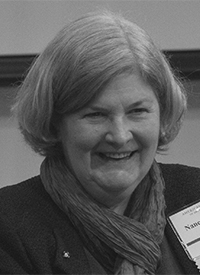
Nancy C. Andrews
Nancy C. Andrews is Dean of the Duke University School of Medicine and Vice Chancellor for Academic Affairs. She is also the Nanaline H. Duke Professor of Pediatrics and Professor in the Department of Pharmacology and Cancer Biology. She was elected a Fellow of the American Academy in 2007 and serves as a Member of the Academy’s Board of Directors. She is a Committee Member for the New Models for U.S. Science and Technology Policy study.
I’m going to talk about a somewhat more mature project than those described so far, the New Models for U.S. Science and Technology Policy study. This project produced the 2014 report Restoring the Foundation: The Vital Role of Research in Preserving the American Dream. Restoring the Foundation includes three prescriptions, which, broadly speaking, address the facts that innovation requires sustainable funding and long-range planning, that current policy and practices actually impede productivity and impact, and that we need a strong ecosystem, including a new government-university-industry partnership. Restoring the Foundation asserts that American science, engineering, and technology are at a critical inflection point, and that the decisions of policy-makers and leaders over the next few years will determine the trajectory of American innovation for many years to come.
In the words of project cochair Norman Augustine, “We must start to think about our future if we hope to have a future.” The benefits of investing in science and engineering research are evident in each of our lives. Our life expectancy is nearly twice that of our grandparents, largely due to victories over devastating infectious diseases, supported by curiosity-driven research. And while new diseases continuously appear, conditions like cancer and coronary artery disease are much less likely to be lethal than they were a generation ago. We carry devices in our pockets – and I’m sure some people are looking at them right now – that not only let us communicate with each other from almost any place on earth, but can instantly provide more information than a library. One point the report makes is that smartphones represent the convergence of multiple lines of basic, publicly supported investigation. The past seventy years of research and innovation have also provided enormous economic benefit through new efficiencies, new businesses, and new careers. But America’s future does not look as bright. We can no longer claim preeminence in many of the areas that we’ve taken for granted. Internationally, our students rank seventeenth in reading, twentieth in science, and twenty-seventh in math. As a country, we are seventh in the world in basic research investment, and over the past twenty years we have dropped from first to tenth place in total research and development investment as a percentage of GDP. As our investment in research has languished, other countries have recognized how vital a strong research enterprise is for economic growth and for the quality of life of their citizens. They’re using our playbook, emulating our twentieth-century commitment to basic research, and in approximately six years, China is projected to outspend the United States in research and development, both in absolute terms and relative to the size of their economy. We risk losing America’s long-held advantage as an engine of innovation that generates new knowledge and products, as well as new jobs and industries.
Our project committee and the American Academy staff have worked hard to bring this message to key decision-makers, including academic leaders, faculty, students, business CEOs, and members of Congress. In the two years since the report was published, the Academy has organized dozens of meetings across the nation, and we have distributed twelve thousand copies of the report. These meetings have included presentations in our nation’s capital. Committee members have been invited to present the report at professional society meetings and to federal agencies. We’ve participated in over 150 meetings with members of Congress and their staff, including two Congressional briefings. And we were invited to testify twice in front of the Senate Committee on Commerce, Science, and Transportation, which authorizes research funding for the NSF, the NIST, the DOD Office of Science, and NASA.
Restoring the Foundation also inspired a statement from ten American business leaders called “Innovation: An American Imperative.” The statement calls for Congress to take seven actions to strengthen American research, including five recommendations from the Academy’s report. Signatories include the CEOs or chairmen of Lockheed Martin, Boeing, John Deere, Northrop Grumman, Merck, Novartis, Microsoft, as well as the National Association of Manufacturers. The statement has now been endorsed by over five hundred companies, universities, and professional societies from across America, including at least one from each of the fifty states. The Academy and its partners issued a report card this past summer on the one-year anniversary of the release of “Innovation: An American Imperative.” One of the seven actions has already been implemented: Congress made permanent a strengthened R&D tax credit at the end of last year. Recently, the Senate Commerce Committee introduced a bill called the American Innovation and Competitiveness Act, which includes several other of our recommendations, such as reducing paperwork burdens on researchers and reaffirming the value of peer review. The bill passed out of the committee on a voice vote, and is awaiting action by the full Senate.
It’s gratifying that so many other organizations have joined the Academy in raising the visibility of the Restoring the Foundation report over the last two years. The Academy will continue to work with partners in years ahead to bring greater visibility to key policy issues pertaining to research, both in Washington and across the nation. As just one example – and I hope some of the Academy’s new members might be interested in this – we’re launching an effort to recruit additional business leaders and public figures from outside of the research community to speak publicly about the importance of investing in basic research, and to lend their voices to the Innovation Imperative effort. All of this activity, I hope, will demonstrate to you that the Academy is not content simply to publish policy recommendations and hope that they’ll be adopted. Rather, we actively engage the key partners and target audiences that will be needed to implement our ideas.
The Public Face of Science
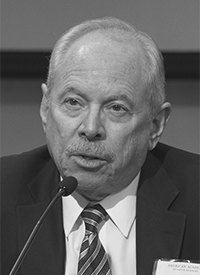
Alan I. Leshner
Alan I. Leshner is CEO Emeritus of the American Association for the Advancement of Science. He was elected a Fellow of the American Academy in 2005. He is an Advisor to the Academy’s project on the Public Face of Science.
I’m going to speak today about a relatively new Academy project, which began just last spring. Over the next three years, the Public Face of Science project will try to understand the factors that shape the public’s attitudes toward science and the ways in which the public uses science. The diverse project committee is led by Richard Meserve and Geneva Overholser, who unfortunately could not be here today. What actually inspired this study, in part, is the disconnect between the public’s great regard for science and technology, and the discontinuity between what scientists and the public believe about an array of critical issues. For example, 37 percent of U.S. adults believe it’s safe to eat genetically modified foods, whereas 88 percent of the scientific community believe GMO foods are safe. There are similar disconnects about whether humans have evolved over time, or whether some childhood vaccines should be required. What this shows is that the public either doesn’t fully understand what science is showing or doesn’t accept science or the scientific consensus. This is a difficult concept for scientists. We all believe that if we ignore, distort, or in some way abuse scientific evidence, we’ll be struck by lightning. The public, of course, can ignore or distort scientific facts at will, with relatively few short-term consequences. And so the issue here is not whether the public likes or appreciates science, or even, at times, understands what the science is showing, but whether the public accepts science – and what to do about it.
This study itself comprises three different pieces. The first concerns trust and perception. We are working with a data advisory group to prepare a benchmark publication featuring data related to public attitudes on science and the nature and outcomes of science engagement experiences. And we are forming new hypotheses to explain emerging trends in the public’s perception of science, while also developing an agenda for generating new data. The second piece will focus on public and media engagement. This includes convening both a public engagement working group and a journalism working group. I was fortunate to attend an Academy meeting in June that brought together a large number of people working around science, communication, and the use of science information. Among other things, the meeting emphasized that science literacy, in fact, is not the driver of public attitudes or the way in which science is used. So these working groups will convene to discuss best practices for scientific journals and public affairs offices and will help connect Academy members with engagement opportunities with nonscientific audiences. The third piece of the project focuses on how science is used to inform specific categories of policy and action. For example, working with Academy Fellows Shari Diamond and Richard Lempert, scientists and legal experts will examine the barriers to effective engagement between science and the legal system. We are currently surveying Academy members about their own experiences with the legal system, which will inform a contribution in an issue of Dædalus devoted to the topic of science and the legal system. We will also look toward how scientific expertise could be more effectively employed in response to crises, especially natural disasters. Led by Gary Machlis, Rita Colwell, and Kristin Ludwig, we will convene a high-level meeting with communication experts, crisis managers, and scientific leaders to develop best practices for involving scientists in disaster response, which will be published in a benchmark white paper.
Through this quick summary, you can see that the common objective of these three pieces is to build a clearer understanding of public interactions with science, technology, and medicine by exploring the broader social contexts that shape how the public uses and considers scientific information. I invite you and encourage you to participate in any way you can. There will be a series of discussions launched with Fellows across the country and, frankly, the Academy hopes to exploit all of you to get a better handle on this topic that has long confounded scientists.
American Institutions
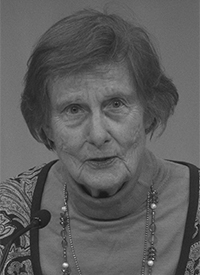
Nannerl O. Keohane
Nannerl O. Keohane is a Senior Scholar at the University Center for Human Values at Princeton University. She served as President of Wellesley College and of Duke University. She was elected a Fellow of the American Academy in 1991 and serves as a Member of the Academy’s Board of Directors.
I’m delighted to welcome all the members of this very distinguished assembly. It’s a great pleasure to share news of some of the work of the Academy, and as you’ve heard, we hope that you will want to become involved. I’m going to give a report, very briefly, on one of our program areas and some of our priorities for the years immediately ahead (in an area we call American Institutions). I’m sure you’ll agree that that focus is warranted, given the current concern about the health and functioning of a number of our national institutions, both public and private. There’s an overlap with some of the other things you’ve heard – public research universities, research investment. But to provide just one other example, for a variety of reasons, a number of members of the Academy have encouraged us to launch a new effort on the civic education of future generations of citizens in this country. There’s ample evidence that young people today are often ill-educated in what we used to call civics: knowledge about our system of government and how to be a responsible citizen of our democracy. As the Academy’s recent projects in the humanities and the education and sciences have suggested, the preparation of American citizens is a lifelong endeavor. We’re all increasingly aware of the importance of lifelong learning, not simply an educational system that pays attention solely to k-12 or even postgraduate degree training. Keeping citizens well-prepared is a moving target, as is, of course, technology and culture change.
Now, the founders of the American Academy, about whom you will hear a lot this afternoon, understood both the importance and some of the difficulties of lifelong education, and they created the Academy partly to address this need. First, they encouraged the creation and sharing of new knowledge for a new republic, but second, they organized the Academy deliberately as a steward of the intellectual life in America more generally. “The end and design of the Academy,” they wrote in the 1780 charter, “is to cultivate every art and science which may tend to advance the interest, honor, dignity, and happiness of a free, independent, and virtuous people.” That objective is our fundamental mission. Trying to ensure that all participants in the American experiment, young and old alike, will be well-prepared. The Academy will soon consider a variety of projects that would return to these roots. A commission on K-12 education, perhaps. The study of particular institutions like our legal system, which Chief Judge Wood will discuss in a moment. These build on past work. For example, the recent Dædalus issues on mass incarceration and immigration, as well as a 2013 issue on American institutions and the common good. So stay tuned for future projects with the same basic aim, and please do share with us your own ideas for these programs. It’s particularly important because the projects that I’ve just described, and others yet to be envisioned, will help build to our 250th anniversary in 2030, which will be an auspicious time to renew our commitment to our founding principles.
I want to mention briefly a brand-new project that will address another critical social issue from a slightly different angle. In early December, the Academy will convene an exploratory meeting. That’s the lowest level of our projects, from exploratory meetings through major projects through commissions. Our task in that exploratory meeting is to have a number of scholars and policy-makers come together to assess the current state of knowledge in the social sciences about the situation of women around the world. We’ll also explore the contemporary debate on issues relating to gender equality and feminism, and then we’ll discuss what role the Academy might play in encouraging the advancement of knowledge about the situation of women around the world, and clarifying and strengthening the debate about the future of women today in all the parts of the world. I’ll be cochairing this meeting with Frances Rosenbluth, professor of political science at Yale and a member of the Academy Council.
This will be the first time that the Academy has addressed gender issues in several decades. There was an issue of Dædalus in 1987 entitled Learning about Women, Gender, Politics, and Power, and one earlier issue of Dædalus in 1964 called The Woman in America. It included a path-breaking essay by Alice S. Rossi that some of you may have heard of, “An Immodest Proposal,” which became a classic in the field. But a great deal has changed for women and for men since 1987, and we think it’s high time to revisit this topic. Frances and I will work closely with Eliza Berg and Francesca Giovannini of the Academy staff, and we hope that the meeting will lead to a larger project that will help us understand the factors that have allowed women to achieve virtual equality in some domains, but remain considerably less than equal in others, and also some of the factors that make crucial life circumstances so different for women in different parts of the world, including education, health, access to resources, experience in marriage, opportunities for leadership. Understanding global feminism in the broadest sense is what we have in mind. This project will draw on multiple disciplines, and we will learn from women around the world and hope to bring together a rich perspective.
Making Justice Accessible
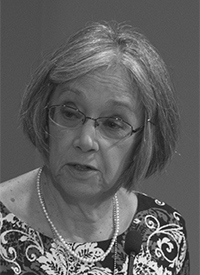
Diane P. Wood
Diane P. Wood is the Chief Judge of the United States Court of Appeals for the Seventh Circuit and a Senior Lecturer at the University of Chicago Law School. She was elected a Fellow of the American Academy in 2004. She serves as the Chair of the Academy’s Council, the Vice Chair of the Academy’s Board of Directors, and a Member of the Academy’s Trust.
This project deals with access to justice in our country – justice in many forms. Each year, millions of Americans are unable to afford a lawyer for cases brought forth in the civil courts. The situation on the criminal side is, perhaps surprisingly, not much better. But these problems are sufficiently different not to fit into this project’s purview. Reflecting this, I’m going to focus our discussion today primarily on the civil courts.
In 2014, which is the last year for which census data were available, sixty-three million Americans were at 125 percent of the federal poverty line or lower. That means, give or take, $30,000 a year for a family of four. At current funding levels, these Americans are not obtaining lawyers for civil court cases. That’s despite the fact that we have a federally chartered agency, the Legal Services Corporation (LSC), dedicated to providing access to legal counsel, in addition to many state-level institutions. These advocates simply do not have the resources to serve every qualified person and, in fact, something on the order of four out of five eligible low-income Americans are not getting assistance through these programs. So millions of Americans are navigating an intimidating, confusing, and complicated legal process without the assistance of a legal professional.
What do we mean when we say civil? We mean the person whose landlord is going to evict her. We mean the person whose mortgage is going to be foreclosed. We might mean the person who bought a product that just didn’t work, and who would like to return it to the store. Or a person who is being hounded by a debt collector despite having made a payment the previous month. We mean the victims of domestic violence. Civil courts deal with all sorts of issues of great importance to our society.
So we recognize the dangers of a legal system built on the user-pays model, which is what we have on the civil side. The federal government created the Legal Services Corporation in 1974 to help ensure equal access to justice, but the LSC is overwhelmed by the amount of need, and congressional funding is at an all-time low. Adjusted for inflation, the LSC’s current budget, which is $385 million a year for the entire country, represents less than half of its original appropriation in 1970. I’ll just give you one comparison that the president of the Legal Services Corporation – a man by the name of Jim Sandman – likes to give in his speeches, because it will appall you. Every year at Halloween time, Americans spend more on costumes for their pets than we spend on the Legal Services Corporation. Never mind your kids; it’s the cat. I say this as a cat-lover, by the way.
The resources are simply inadequate, and the effects are immediately recognizable. In Massachusetts, where we happen to be right now, 64 percent of eligible residents were turned away, and that may be a rosy picture, because here the state actually throws in some resources to help. Many people don’t realize that their problem is a legal problem and that they might be able to get some assistance for it, as in the case of a family being evicted from their apartment. In a report to the chief judge of New York in 2010, a task force to expand access to civil legal services noted that 99 percent of tenants are unrepresented in eviction cases, 99 percent of borrowers in consumer credit cases are unrepresented, and 97 percent of parents are unrepresented in child support matters. That’s in New York City. These local statistics are gathered at the behest of the local courts or various NGOs. The data are quite spotty, and aren’t uniform across states. So it’s very difficult to see what’s going on at the national level. What data we do have are often unreliable and fall short of enabling more than surface-level analysis of this giant problem. This finding was echoed by a White House legal aid interagency roundtable.
On November 11 and 12, 2015, just about a year ago, the American Academy hosted a very successful symposium on the state of legal services for low-income Americans. This symposium was organized by a small committee led by John Levi, an Academy Fellow and chair of the board of the Legal Services Corporation, and it was sponsored by the Academy’s Exploratory Fund, which has been a wonderfully flexible tool to try out and develop an idea and see if there is potential for further study and Academy involvement. At a minimum, the fund has brought together Academy Fellows and other experts across disciplines to discuss problems of shared interest. Our meeting included federal and state judges, legal scholars, and legal-services providers. Those present quickly reached the conclusion that this is a social problem of the highest magnitude, demanding a country-wide social and political response. The symposium also concluded that we could not think sensibly about the topic until we knew what data we have, what they cover, what data we’re lacking, and how to go about getting the missing information. So with realistic expectations, we launched a data collection project.
And that is, in fact, where we are now. Mark Hansen and Rebecca Sandefur are the chairs of the project and are working to set a research agenda. Our group, with the Academy’s help, is investigating what funding sources and potential partners are out there, what the obstacles to further research are, what is possible with the resources we now have, and what data need to be collected. Further, we are organizing – this is a common theme you’ve heard this morning – an issue of Dædalus on this topic, which will be edited by four leading experts on the issue: David Tatel, who is a judge on the United States Court of Appeals for the District of Columbia Circuit; Lance Liebman, professor and former dean of the Columbia Law School; Rebecca Sandefur, whom I mentioned a minute ago, professor of sociology at the University of Illinois; and Lincoln Caplan, who’s a visiting lecturer at Yale. This will be another way in which we will get the word out and try to take advantage of the Academy’s convening capabilities. The Academy isn’t just one little narrow group of lawyers or social scientists, but a diverse group of people who can think sensibly about the scope of this problem, the costs of not solving it, and what might be done. The final thing I will say is that the Academy has often served as a catalyst for a national discussion about issues. That’s exactly what happened with our Heart of the Matter report on the humanities and social sciences. And as the Academy approaches its 250th birthday, this project may very well help shape a national conversation.
Exploratory Projects
The Future of Jazz in American Life
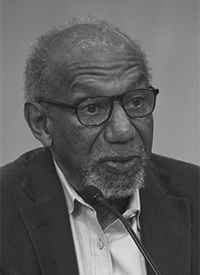
Felton Earls
Felton Earls is Professor of Human Behavior and Development, Emeritus, at the Harvard T. H. Chan School of Public Health, as well as Professor of Social Medicine, Emeritus, at Harvard Medical School. He was elected a Fellow of the American Academy in 1993.
I’d like to be a little autobiographical about this. I grew up in the shadow of jazz in New Orleans. In 1963, I joined a group of senior undergraduate students at my university, Howard University, and went to the dean of the music school, whose name was Warner Lawson, and proposed to him that we – the university – grant Duke Ellington an honorary degree that year. Much to our surprise, Dean Lawson said that he would not consider that, because jazz, even with a distinguished composer like Duke Ellington, was a degenerate form of music; that only spirituals had the integrity and the musicality of something that deserved an honorary degree. And so it came as a great surprise to me, in 1993, thirty years later, when I was inducted into the Academy, to find out that Ellington had been inaugurated as a Fellow in 1970, four years before he died in 1974. So that put a cricket in my brain, and it rested there until Academy President Jonathan Fanton proposed the exploratory grant mechanism, and right away the cricket started to chirp. Wouldn’t it be interesting to have the Academy review the vitality, the vulnerability, and the fragility of this truly American art form?
And so I got together with William Damon, a jazz buff buddy of mine who had just been inducted, and we applied for the grant Jonathan had announced. We wrote a letter, saying we’d like to convene a group of professors and performers and people interested in the marketing of jazz – to get an eclectic group around the table to think through the vitality of this music in contrast with its vulnerability in the market. Jazz, over the last thirty years, has gone beyond Europe and Africa, and is having quite an impact internationally, in Korea, Japan, and China, among other places. So this music that originated in America has become a truly global art form. But the soil it grew in is being depleted. So we convened the meeting last May, and as a result, Gerald Early from Washington University in St. Louis and Ingrid Monson from Harvard, two professors of music and art, have agreed to put together a volume of Dædalus on the future of jazz.
What the Exploratory Fund has allowed me to do, living in the shadow of jazz all these years, is to plant this seed. I think that the Dædalus volume will be a great opportunity to enrich the environment, to move the Academy a step closer to representing jazz as an art form that is uniquely American in its origin and global in its influence.
Preserving Intellectual Legacies in a Digital Age
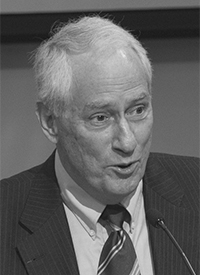
Robert Darnton
Robert Darnton is the former Carl H. Pforzheimer University Professor and Director of the University Library at Harvard University. He was elected a Fellow of the American Academy in 1980.
I would like to offer a few words on an Exploratory Fund project entitled “Preserving Intellectual Legacies in a Digital Age.” Twenty-six participants met here at the Academy on September 23. We sat around a donut-shaped table in the other room and talked and talked. People came from many different disciplines, and they all addressed the same problem, which all of you, I’m sure, have thought about: how to preserve digital material now that we are deep in the digital age. You might ask, how deep? Well, we now have what we call digital natives. That is, children who learned to play on screens before they learned to read. We also have digitally born documents, which left no trace on paper whatsoever. The conjunction of these two, I think, is pointing us toward a future in which the dangers of nonpreservation are tremendous, for ourselves today, but also for future generations.
I’ll give you a rapid-fire version of some of our prophecies of doom and some of our suggestions in response. One speaker, Abby Smith Rumsey – former program manager at the Library of Congress – reminded us that 80 percent of silent films have just disappeared. We have no record whatsoever of this major art form. I don’t know how many jazz performances have been lost, but I would think the great majority have also vanished into the air. Movies and videos continue to be lost, in part because the Library of Congress does not require that copies of them be deposited in its archives. All sorts of commercial companies now provide cultural content without even giving a thought to the preservation of that content. We need to make the Library of Congress an obligatory deposit library for digital works in all formats, Abby Smith Rumsey concluded.
Another speaker, Jonathan Zittrain, a professor of law at Harvard and also the Harvard Law librarian, offered an equally chilling reminder. Seventy-five percent of the articles in the Harvard Law Review are inaccessible online because of link rot. He favors some kind of compulsory licensing that would provide for preservation. A third speaker, Dan Cohen, who is the executive director of the Digital Public Library of America, concurred. Facebook, he remarked, now produces the largest amount of data among all companies, yet it does nothing whatsoever to preserve the material. He argued that we need to develop a default to preservation in our communication systems so that digital ephemera will be saved for the use of future generations. Mahadev Satyanarayanan, the professor of computer science at Carnegie Mellon known for developing Dropbox and the so-called Internet of Things, which is a fascinating topic, emphasized the importance of one poorly understood aspect of preservation: not just the preservation of hardware and software, but the preservation of what he called software executability. That is, the necessity of developing technology to ensure that software that has been preserved for the future will actually function as it did in the past, which requires a very difficult process of aligning all sorts of moveable, digital parts. And as if that were not difficult enough, Kenneth Prewitt, former director of the U.S. Census Bureau who is now a professor at Columbia, reminded us that a great deal of this technology, of course, depends on algorithms that are trade secrets.
By this time, the mood in our group was shifting toward disconsolate pessimism, but there were optimistic moments, which I’ll mention very quickly. Brewster Kahle, the head of the Internet Archive, set a positive tone through a rousing talk at a dinner before the workshop met the following day. He represents what you could call seat-of-the-pants pragmatism. A great representative of the MIT ethos, he says, “just do it.” The idea is to jump in, to take risks, to try out solutions, weed out the failures, and keep what works. That sounded pretty good. Then the poet Robert Pinsky expressed the pessimistic outlook the following day. “We can learn to succeed in creating works,” he said, being a great creator himself, “but we can’t wrap our minds around the problem of preserving them.” “What does a hog know about bacon?” he asked. Well, that left us really uncomfortable.
Then the discussion shifted to the theme of accessibility, even in the present, as well as the future. Mike Furlough, the executive director of the digital library HathiTrust, challenged the notion – and I think it’s a very widespread illusion – that everything is, or soon will be, available online. It’s absolutely false. Although HathiTrust’s gigantic preservation repository contains thirteen million digitized volumes, deposited by 115 institutions, it lacks an enormous amount of material that belongs to this famous category you keep hearing about, the unknown unknown. So, he argued, we should develop a strategy for assessing what we have failed to preserve nationwide, and how we should make it accessible. Pamela Samuelson, Carla Hesse, and Molly Shaffer Van Houweling, all from the University of California, Berkeley, discussed the ways copyright laws prevent that kind of access, including access to most of the books published in the last century. They advocated changes in copyright, such as a provision for authors to disseminate their own work if it is no longer being sold by publishers. The workshop was actually inspired, in large part, by Pamela Samuelson and Carla Hesse. They have created a project known as the Authors Alliance, which is trying to do exactly that. Perhaps I could say that we didn’t leave the meeting feeling happy about the problems of preservation, but we raised our consciousness.
Preserving Cultural Heritage
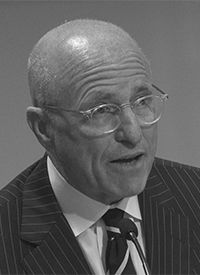
James Cuno
James Cuno is President and CEO of the J. Paul Getty Trust. Elected a Fellow of the American Academy in 2001, he serves as the International Secretary of the Academy and is a Member of the Academy’s Council.
I should say that the meeting I am about to describe was born from a conversation that Jonathan and I had after a panel discussion just like this, one year ago. So I encourage you to follow through on your own interests, or interests that may develop from today’s meeting.
On February 26, 2001, the Taliban leader Mullah Mohammed Omar called for the destruction of all statues of non-Islamic shrines in Afghanistan. He said that these statues have been and remain shrines of unbelievers, who continue to worship and respect them; God almighty is the only real shrine, and fake idols should be destroyed. A few days later, the sixth-century monumental statues carved into a cliff in the Bamiyan Valley of central Afghanistan – which testified to the majesty of Buddhist art and its transmission from India into Central and Eastern Asia – were hit by antiaircraft and tank fire before being blown up by dynamite. Neither a meeting between the Taliban foreign minister and the Secretary General of the United Nations, Kofi Annan, nor the statues’ inscription on the UNESCO World Heritage Site list could prevent their destruction.
The Great Mosque of Aleppo was built between the eleventh and fourteenth centuries on the site of the former agora of the Hellenistic period – and purports to contain the remains of Zechariah, the father of John the Baptist. In April 2013, for unclear reasons, its minaret was destroyed, some say by Syrian rebels, others say by the Syrian Army. Both the mosque and the minaret were inscribed as an UNESCO World Heritage Site, though, again, this did not preserve them.
On February 26, 2015, ISIS released a video showing its fighters attacking and destroying statues and artifacts in Mosul, Iraq, dating from the Assyrian and Akkadian empires from the eleventh to eighth centuries BC. The ISIS attackers justified their actions by referencing the Prophet Muhammad’s destruction of idols in Mecca, arguing that if God ordered the removal of these statues and idols, these artifacts become worthless to us. In response to these and similar attacks, the UN Security Council adopted eight resolutions affirming the sovereignty and territorial integrity of Syria and Iraq, and condemned ISIS and its destruction of cultural heritage. On May 28, 2015, the UN General Assembly unanimously adopted a similar resolution.
Most recently: the oasis town of Palmyra, which was one of the great trading centers of antiquity, connecting the civilizations of the Mediterranean with Mesopotamia and the empires of the East. For centuries, its Roman-era ruins stood as monuments to Arab glory and Levantine cosmopolitanism. Then it was attacked by ISIS fighters. Its most important shrine, a first-century temple dedicated to the Mesopotamian god Bel was reduced to rubble. Then a second temple, dedicated to the other Palmyran deity Baalshamin, was blown up. Then the triumphal arch on the colonnaded main street, which may have commemorated the Roman victory over the Parthians, was destroyed, followed by the demolition of several of the city’s tower tombs. Finally, the local archeological museum was sacked, although much of its collection had been removed to Damascus for safekeeping, given that they were moveable heritage items. Not stopping at the museum and its artifacts, ISIS also beheaded the eighty-one-year-old Palmyran antiquity scholar, Khaled al-Assad, and hung his mutilated body on a column in a main square, because he allegedly refused to reveal to them where the artifacts had been moved for safekeeping. Needless to say, Palmyra was inscribed on the list of UNESCO’s World Heritage Sites, and still was heavily damaged.
Such deliberate attacks on cultural heritage have not been limited to the Middle East. In 2012, al Qaeda – linked rebels occupied a breakaway mini-state in the northern half of Mali, including the Saharan city of Timbuktu. They enforced a strict interpretation of Islamic law, and destroyed nine mausoleums with pickaxes, hoes, and Kalashnikovs. Among the mausoleums were those of Sidi Mahmoud Ben Amar, a renowned Muslim scholar and Sufi saint who died in 1547, and the Sidi Yahya, whose mausoleum also served as one of the three great mosques in the city, dating from the fifteenth century. A year later, a French-led military force recaptured Timbuktu and arrested Ahmad al-Faqi al-Mahdi for participating in the destruction of the mausoleums. Al-Mahdi’s conviction by the International Criminal Court in the Hague was the tribunal’s first conviction for the destruction of religious buildings or historic monuments, and whether it will lead to additional convictions for the attacks in Mali, Iraq, and Syria is unclear, for al-Mahdi was apprehended first, and was turned over to the ICC for prosecution only because Mali is a party to the Rome Statute that created the ICC; Iraq and Syria are not.
This raises the question of the effectiveness of the international community’s responses to the attacks on cultural heritage in conflict zones. To date, the international community’s responses have been limited to declarations of outrage, inscribing important cultural heritage sites on a world list, and passing UN resolutions condemning such acts of violence. Clearly, more needs to be done. First, we have to recognize that with the formation of new nation-states following the collapse of empire, cultural heritage that fell within the sovereign borders of those states has become state property. This has limited, and in most cases stopped, the practice of partage, which distributed archeological finds between excavators and local authorities. It has also made it difficult to create safe harbors for moveable cultural heritage, such as sculptures, mosaics, and manuscripts. A recently signed U.S. law, for example, allows for safe havens only on the basis of a waiver of import restrictions at the invitation of the country that owns the artifacts. In any case, this law does not address threats to the immoveable cultural heritage, like those temples that we saw blown up in Palmyra, the Great Mosque of Aleppo, or the mausoleums in Timbuktu. And so the American Academy and the J. Paul Getty Trust have joined together to invite international legal scholars, museum and conservation professionals, and government and diplomatic leaders to a meeting to be held at the British Academy in London next month, where together, in cooperation and collaboration with colleagues around the world, we will explore the feasibility of a broad legal and diplomatic framework modeled on the responsibility to protect framework adopted by all members of the United Nationals General Assembly at the 2005 World Summit. That framework was directed at the prevention of genocide and mass atrocities, and our task is to see whether something comparable couldn’t be directed at the prevention of destruction of cultural heritage. The question we will explore is, if states have the obligation to protect cultural heritage within their sovereign borders, what responsibility does the international community have when the state is unable to or unwilling to exercise that obligation, such as in Syria, where the state does not have control over its sovereign territory.
The American Academy is well-positioned to take on this task, because the committee that wrote the original responsibility to protect report was chaired by Academy Fellow Lloyd Axworthy, with support from Academy Fellow Kofi Annan, and financial backing from Academy President Jonathan Fanton, then head of the John D. and Catherine T. MacArthur Foundation. The Academy is not new to this kind of work. In 1947, the Academy sent Bart Bok as its representative to the First National Conference on UNESCO. He worked actively for UNESCO’s program in the natural sciences. Then, in November of that year, the Academy’s Committee on UNESCO issued a conference report to the State Department, which served as preparatory material for the U.S. National Commission to UNESCO. It’s on this foundation that we intend to explore the legal framework for the protection of cultural heritage, recognizing that in times of violent conflict, innocent people and the world’s cultural heritage are both at risk.
© 2017 by Pauline Yu, Michael S. McPherson, Robert J. Birgeneau, Rubén G. Rumbaut, Steven E. Miller, Robert Legvold, Tanisha Fazal, Karl W. Eikenberry, Nancy C. Andrews, Alan I. Leshner, Nannerl O. Keohane, Diane P. Wood, Felton Earls, Robert Darnton, and James Cuno, respectively.